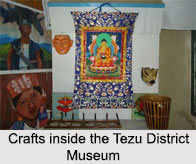 Tezu, a small town, is located in Lohit District of Arunachal Pradesh. This town is situated amidst the Mishmi Hills. Singhpos, Khampti and Mishmi tribes are the old inhabitants of this beautiful land of valleys and rivers; Miju and Digaru are the other minor tribes of this region. Tezu town is vivid with the traditions of these tribes. Lohit River is located 21 km from Tezu, on the banks of which Parashuram Kund is situated.
Tezu, a small town, is located in Lohit District of Arunachal Pradesh. This town is situated amidst the Mishmi Hills. Singhpos, Khampti and Mishmi tribes are the old inhabitants of this beautiful land of valleys and rivers; Miju and Digaru are the other minor tribes of this region. Tezu town is vivid with the traditions of these tribes. Lohit River is located 21 km from Tezu, on the banks of which Parashuram Kund is situated.
Tourism in Tezu
Tezu is one of the most attractive tourist spots with several picturesque views of lakes, wildlife sanctuary and religious sites. Apart from that some other attractive places, which tourists often like to visit in Tezu, are:
Dong: Dong Valley, situated at the confluence of Sati and Lohit rivers, is the easternmost village of India. The valley, located at an altitude of 1240 meters, is the first to receive the ray of rising Sun on every morning. The location of the valley is strategic as it is situated on the tri-junction of India, Mayanmar and China.
 Glow Lake: Glow Lake, having snow-capped mountains on the backdrop and lush greenery around, is situated in Wakro Circle at an altitude of 5000 feet covering 8 sq km area. The path leading to the lake is often considered to be a good scope for trekking.
Glow Lake: Glow Lake, having snow-capped mountains on the backdrop and lush greenery around, is situated in Wakro Circle at an altitude of 5000 feet covering 8 sq km area. The path leading to the lake is often considered to be a good scope for trekking.
Parashuram Kund: Parashuram Kund, popular for its religious significance, is located on the Brahmaputra plateau in the lower reaches of Lohit River. The Kund has been mentioned in ancient literature as well. During Makar Sankranti, people gather on this place from all over the India just to take a dip in the Kund, because it is believed to be a holy deed to wash off one"s sins.
Tezu District Museum and Craft Center: This museum of Tezu exhibits the culture and tradition of the tribes of this place in proper form. Established in the year 1956, the museum showcases a rare collection of paintings, manuscripts, weapons, costumes and ornaments which are used by the tribes. It also exhibits the creativity of Cane craft and handloom craft. The museum was established with the aim to promote the cultures and traditions of the tribes of Tezu.
D"Ering Memorial Wildlife Sanctuary: The sanctuary, established in 1976, is spread over an area of 190 sq km; earlier it was named as Lali Wildlife Sanctuary. This place is the house of different species of animals like tiger, hog, elephant, wild pig and deer; Sambar deer is the specialty of this sanctuary. Including some endangered birds, this sanctuary houses over 150 species of birds. 80% of this place has floodplain grasslands.
Tezu Botanical Garden: The garden covers a land of 23 hectares and it houses a wide range of plants which include some rare species of plants as well. Different methods of cultivating and preserving of plants are practiced in Tezu Botanical Garden.
 Tezu Park: Tezu Park is a great place to spend some quality time. There are some rides also in this park for the enjoyment of the children.
Tezu Park: Tezu Park is a great place to spend some quality time. There are some rides also in this park for the enjoyment of the children.
Nearby Places of Tezu
Apart from the places mentioned above, here are some nearby places of Tezu which tourists often visit while traveling in Tezu. The names of the places are Hawa Camp, Walong and Chaglogam etc. Hawa Camp is 33 km, Walong is 200 km and Chaglogam is 170 km from Tezu.
Visiting Information to Tezu
The best time to visit Tezu is from November to February. Tezu Airport is there to reach the place by flights. Tinsukia is the nearest railway station of Tezu to reach by trains and regular buses are available from Guwahati to Tezu.



















